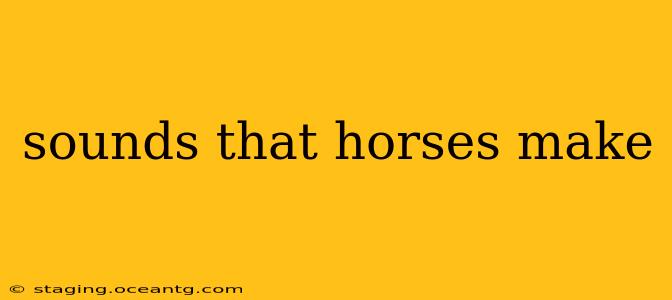Horses are majestic creatures, and their communication extends far beyond simple neighs. Understanding the nuances of equine vocalizations offers a fascinating glimpse into their social lives, emotional states, and even physical well-being. This comprehensive guide will explore the diverse sounds horses make, helping you decipher their equine language.
What are the common sounds horses make?
The most familiar sound a horse makes is, of course, the neigh. A neigh can serve many purposes, from a long-distance call to a greeting between familiar horses, or even an expression of excitement or distress. The pitch, duration, and intensity of the neigh can all provide subtle clues to the horse's emotional state. A high-pitched, drawn-out neigh might indicate alarm, while a shorter, softer neigh could be a friendly greeting.
Beyond the neigh, horses use a variety of other vocalizations, often subtle and easily missed by the untrained ear. These include:
-
Snorting: A short, sharp expulsion of air through the nostrils. This often indicates alertness or a mild warning. It can be a response to a perceived threat or simply a way of clearing dust or debris from the nasal passages.
-
Whinnying: A softer, higher-pitched sound than a neigh, often used for communication between mares and foals. It can also express a gentler form of distress or anxiety.
-
Nicker: A soft, low-pitched sound, almost a murmur, often used as a greeting or a sign of affection. Think of it as the equine equivalent of a gentle murmur. It's usually a welcoming sound.
-
Squealing: A high-pitched, often sharp sound, that can indicate pain, fear, or frustration. It's usually a sound of distress and should be investigated.
What does it mean when a horse snorts?
As mentioned above, snorting can have several meanings. It often signifies alertness or a mild warning, but it can also be a way to clear the nasal passages. A horse might snort in response to a sudden noise, movement, or smell. The context is crucial to interpreting the snort’s meaning. A repeated snorting, especially accompanied by other signs of distress, might suggest a problem requiring veterinary attention.
What sounds do horses make when they are scared?
A scared horse might exhibit a variety of sounds depending on the level of fear. These could include a high-pitched neigh, a squeal, or even a series of rapid snorts. They may also exhibit non-vocal signs of fear, such as pinned ears, wide eyes, and a raised tail. Understanding these non-vocal cues is just as important as interpreting the sounds themselves.
What sounds do horses make when they are in pain?
Pain in horses can manifest in various ways, both vocally and non-vocally. A horse experiencing pain might squeal, neigh loudly, or make other unusual or distressed vocalizations. They might also show signs of discomfort through their body language, such as pawing the ground, rolling, or refusing to move. If you suspect your horse is in pain, veterinary attention is crucial.
Do horses have different sounds for different situations?
Absolutely! Horses' communication is remarkably nuanced. The context in which a sound is made is just as important as the sound itself. A neigh in a pasture with other horses is different from a neigh when alone and separated from the herd. The same sound can convey vastly different meanings depending on the surrounding circumstances and the horse's body language.
Conclusion: Listening to the Equine Language
Learning to understand the subtle variations in equine vocalizations and body language takes time and observation. By paying close attention to the context of the sound and the accompanying behaviors, you can gain valuable insight into the emotional state and well-being of the horse. This knowledge fosters a deeper connection and allows for better care and communication with these magnificent animals.
